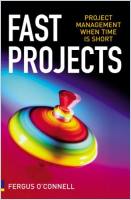Why did I choose this resource?
I chose this resource to learn how to complete projects on or before the due date.
What did you learn from it?
I learned the best ways to plan and correctly estimate a budget for a project. As well as how to turn an “impossible” or failing project into a possible one that will be completed on time.
Key Knowledge
- “Say, ‘We’ll Take a Look at It’”
- Refuse to accept conditions on a project until you review all details of the project
- Beware the stakeholder’s who use the phrase, “We don’t know much about this project, but it has to be done by this date… with the team you’ve got, and the budget is fixed.”
- Completely impractical
- “The Goal of Your Project”
- Ask, “What event marks the end of this project?”
- Determines a project’s goal
- List the stakeholder’s “win-conditions,” desired results
- Identify the project’s “end point,” date all win-conditions will be met
- List project components
- Differentiate “have-to-have” from “nice-to-have”
- Project boundary is determined by the list of haves
- Ask, “What event marks the end of this project?”
- “Figuring Out What Work Has to Be Done”
- Work with your project team
- List the required jobs of the project
- Define main jobs
- Divide into component tasks
- Assign time to each job
- One to five days’ length
- One to five “person-days of work”
- Create the WBS (Work Breakdown Structure) using the job list
- Monitor progress with a project management tool (your choice)
- Project management time should be 10% of the total WBS
- Speed up the process
- Classify daily work breakdown for each job
- “day-by-day, person-to-person plan”
- Classify daily work breakdown for each job
- “Getting People to Do the Work”
- Balance supply (funds, people, resources) and demand (time, budget, quality)
- Catalog worker’s by name and check availability
- Complete a “dance card,” chart of days available
- “Making the Plan Bulletproof”
- ALWAYS expect the unexpected
- Perform a risk analysis
- Scale 1-3, likeliness of risk occurring
- Scale 1-3, possible negative impact
- Multiply both values to determine total risk score
- Attempt to eliminate, mitigate, or plan for potential risks
- Add a contingency allotment of 10% to 15% above total planned work hours
- “Selling the Plan”
- Perform 2 meetings; first with executives and “external stakeholders,” second with the project team
- Deliver the plan
- Create the big picture
- go into detail
- Explain the contingencies
- Discuss the risk analysis
- Answer questions
- Perform 2 meetings; first with executives and “external stakeholders,” second with the project team
- “What to Do If the Project Is Impossible”
- Create a plan to determine if possible/impossible
- Steps, timeline, specific jobs, quality issues, budget, necessary resources
- If becoming impossible
- Decrease the project scope
- Concentrate only on have-to-have items
- Check for possible changes to be made to conditions, specs, or parameters
- Ask about built in contingencies
- Try to reduce quality assurance requirements
- Shorten process for obtaining sponsor sign-offs
- Use your fact based plan to prove that stakeholder’s baggage is currently preventing the project from being completed on time
- Create a plan to determine if possible/impossible
How are you using what you learned?
I am using what I learned to review our current project planning process and to create a re-evaluation plan for projects that are in danger of becoming impossible or being completed late.
Key Changes / Key Actions
- Evaluate current project planning methods
- Create re-evaluation plan
Source
- Name : Fast Projects
- Author : Fergus O’Connell
- Resource: Link to Book


